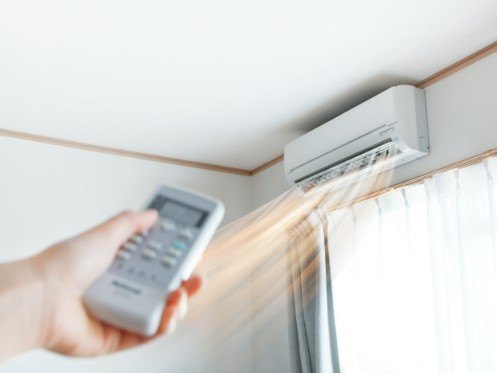Here in the Tampa, FL, area and the rest of the U.S., central air conditioning and heating dominate the residential HVAC market. In-wall ductwork and central HVAC systems offer reasonably efficient heating and cooling at affordable prices. However, there are many homes that rely on ductless mini-split systems for their heating and cooling needs. These systems are becoming more popular in the Tampa area because mini-splits often beat central HVAC systems when it comes to efficiency. Here’s everything you need to know about mini-split efficiency and how they achieve their often unbelievably high efficiency levels.
What Is a Ductless Mini-Split?
A ductless mini-split is a type of HVAC system that doesn’t rely on in-wall ductwork to heat and cool your home. Instead, a mini-split requires an outdoor unit, like a conventional air conditioning system, and individual air handlers installed throughout your home. The air handlers each connect to the outdoor unit by way of refrigerant lines and a power cable.
Why Are Mini-Splits So Efficient?
There are a variety of reasons why ductless mini-splits are among the most efficient HVAC systems on the market. Of course, the most obvious reason is their lack of reliance on ductwork. According to the U.S. Department of Energy, ductwork is one of the biggest sources of energy loss for a conventional HVAC system. They estimate that such systems often see energy losses of up to 30% due to ductwork issues like air leakage and convective losses resulting from inadequate insulation.
Additionally, ductless mini-splits often use heat pump technology to operate. This means they consume energy only to move heat from one place to another, both in heating and cooling modes. In heating mode, heat pumps operate at efficiency levels that conventional furnaces can’t come close to. For example, the most efficient gas furnace you can buy operates at 98.5% efficiency. And electric furnaces, which are popular here in Tampa, operate at 100% efficiency. That seems unbeatable until you realize that a mini-split heat pump can deliver efficiency levels up to 400% when operating in ideal conditions.
This is possible because, unlike conventional heating systems, heat pumps don’t convert energy into heat. They collect existing heat energy from the outdoor air and carry it indoors to heat your home. The only electricity they consume is to run a compressor to manipulate the pressure of a refrigerant and some fans to move air across their heat exchangers.
In cooling mode, a ductless mini-split can offer efficiency levels on par with or superior to today’s best central air conditioning systems. Consider that the most efficient central air conditioner on the market today has a seasonal energy efficiency ratio (SEER) rating of 28. However, you can find mini-splits with SEER ratings as high as 42.
Of course, the efficiency advantages of mini-splits don’t end there. This equipment has an efficiency advantage because it offers zoned heating and cooling by default. This means you can set a different temperature in each room where there’s an air handler installed. That eliminates energy waste by preventing you from overheating or overcooling the rooms in your home. Plus, you can turn off individual air handlers in rooms you’re not using to save even more energy.
Mini-splits often include advanced technology that helps them operate even more efficiently. For example, plenty of mini-splits now feature inverter technology and variable-speed fans. This allows a mini-split’s control circuitry to run the system’s compressor and blower motors at the lowest possible speed to achieve the set temperature you desire. Central AC systems typically have only two settings: on or off. A mini-split offers more energy savings through more detailed operating controls.
Mini-splits also tend to use the latest refrigerants. For years now, more than 80% of residential heat pumps have used R410A as their primary refrigerant. It features a near-perfect operating temperature range and excellent heat absorption capabilities. Some heat pumps use a refrigerant known as R-1234y, which has similar properties to R410a. However, it also breaks down quickly in the atmosphere, so it poses almost no environmental danger if released. There are even heat pumps coming to market that use gasses, like propane and CO2 as refrigerants, which promise even greater efficiency in the coming years.
Conditions That Affect Mini-Split Efficiency
While ductless mini-splits are very efficient, they aren’t perfect. One of their weaknesses is that they lose efficiency in extremely cold weather. A heat pump must work harder to capture heat energy from colder air because there’s less heat energy available.
As a result, heat pumps begin losing some efficiency once the temperature outside drops below 40 degrees Fahrenheit. However, they still outperform conventional heating systems down to about 25 degrees. At that point, a high-efficiency gas furnace becomes the more efficient option. The good news about that is that we don’t see weather that cold here in Tampa very often. The average low temperature in January here is 53 degrees. At those temperatures, heat pumps will be an extremely efficient heating option.
Also, maximizing the efficiency of a mini-split setup requires expert installation. This ensures optimal placement of the mini-split’s air handlers and outdoor unit. If a mini-split’s air handlers aren’t installed in the right places, your mini-split has to work harder to maintain the temperature you’ve set. The same thing is true of your mini-split’s outdoor unit. Here in Tampa, a mini-split works hardest in the summer. This means the ideal spot for your mini-split’s outdoor unit is a shady spot with unrestricted airflow. That provides the perfect environment to support heat transfer in the summer. And since it doesn’t get too cold here in the winter, a mini-split’s outdoor unit won’t need direct sunlight for optimal operation.
Mini-splits also require periodic maintenance to keep working as efficiently as possible. You will need to clean each air handler’s washable air filter every two weeks. You will also need to wipe down your mini-split’s condenser coils, located in its outdoor unit, every few months. This helps your mini-split maintain the most efficient heat transfer with the outside air. And you’ll need to schedule at least one maintenance visit from one of our expert HVAC technicians each year to keep it in good working order.
Tampa’s Ductless Mini-Split Specialists
If the efficiency benefits of a ductless mini-split sound like a beneficial option for your household and budget, we here at Protek Roofing, Heating, Air & Solar can help. We encourage you to reach out to us for more information. We offer comprehensive HVAC installation, maintenance, and repair services for all makes and models of HVAC systems. This includes ductless mini-split systems. Plus, we also offer indoor air quality services, roofing services, and solar services as well. If you’re looking to improve the comfort of your indoor environment while moving toward the highest possible energy efficiency, we’re the place to turn.
For ductless mini-splits and all of your other HVAC needs in Tampa, contact the experts at Protek Roofing, Heating, Air & Solar today.




